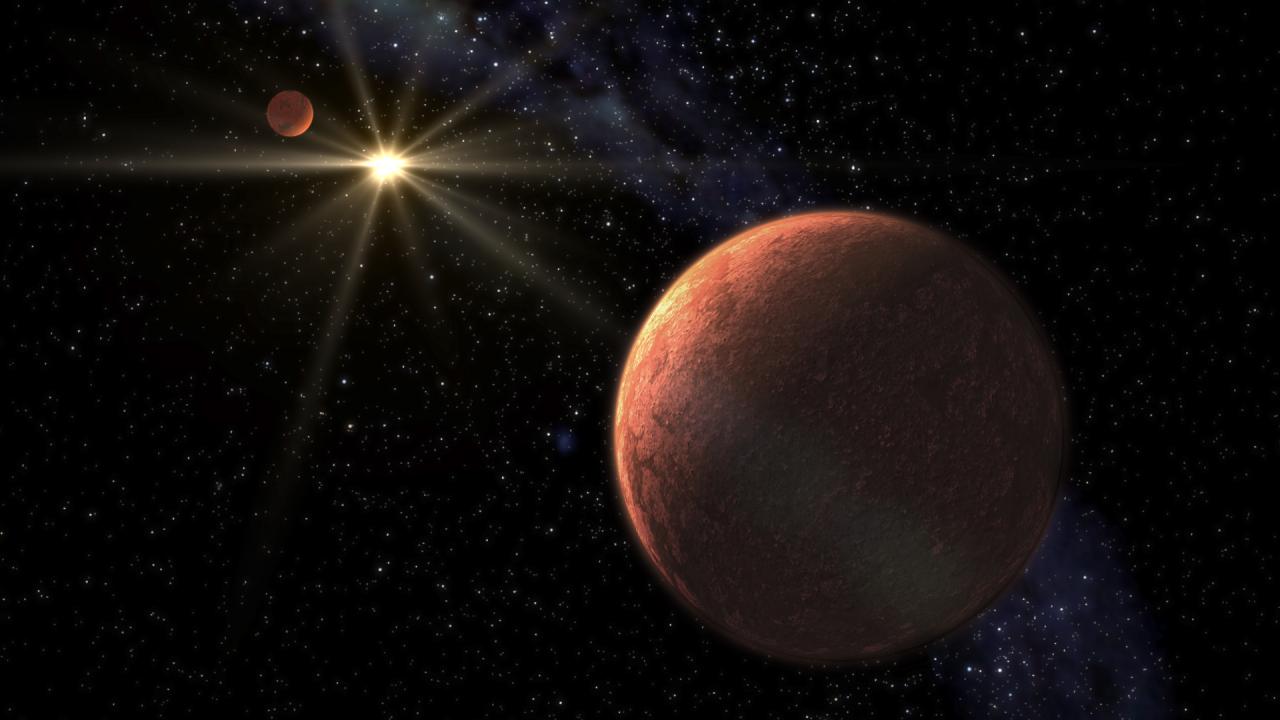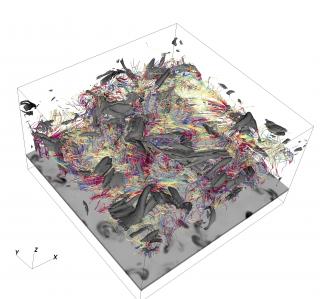General
Our goal is to study the processes that lead to the formation of low mass stars, brown dwarfs and planets and to characterize the physical properties of these objects in various evolutionary stages. Low mass stars and brown dwarfs are likely the most numerous type of objects in our Galaxy but due to their low intrinsic luminosity they are not so well known. We aim to study the frequency, multiplicity and spatial distribution of these objects in the solar neighbourhood and in nearby star forming regions and stellar clusters in order to better understand the mechanism of formation, characterise their optical and infrared properties and establish the relation between spectral properties, mass and luminosity.. Most of our effort will be dedicated to push toward lower mass limits the detection of these astros either bounded to stars and brown dwarfs and/or free-floating in interstellar space. The lowest mass objects display a lower intrinsic luminosity and cooler effective temperatures thus they are remarkably difficult to detect using direct imaging techniques. However, these techniques allow a full photometric and spectroscopic characterization and a best determination of their physical and chemical properties. We also aim to investigate the presence of planets around low mass stars using radial velocity measurements and techniques for high spatial resolution imaging. We will develop ultrastable spectrographs for large telescopes and systems for ultrafast imaging. With the spectrographs it would be possible to detect planets of similar mass to the Earth around G, K and M-type stars. The goal is to establish the frequency of these planets in stars of the solar neighbourhood and characterise the properties of the associated planetary systems.
Members
Results
- The optical and near-infrared sequence of 10 Myr-old L dwarfs in the nearest OB association to the Sun, Upper Scorpius
- The lithium depletion boundary of the Hyades cluster.
Scientific activity
Related publications
-
The GAPS programme with HARPS-N at TNG. I. Observations of the Rossiter-McLaughlin effect and characterisation of the transiting system Qatar-1
Context. Our understanding of the formation and evolution of planetary systems is still fragmentary because most of the current data provide limited information about the orbital structure and dynamics of these systems. The knowledge of the orbital properties for a variety of systems and at different ages yields information on planet migration and
Covino, E. et al.Advertised on:
62013 -
The GAPS programme with HARPS-N at TNG. II. No giant planets around the metal-poor star HIP 11952
In the context of the programme Global Architecture of Planetary Systems (GAPS), we have performed radial velocity monitoring of the metal-poor star HIP 11952 on 35 nights during about 150 days using the newly installed high-resolution spectrograph HARPS-N at the TNG and HARPS at the ESO 3.6 m telescope. The radial velocities show a scatter of 7 m
Desidera, S. et al.Advertised on:
62013 -
Astrometric and photometric initial mass functions from the UKIDSS Galactic Clusters Survey - IV. Upper Sco
We present the results of a proper motion wide-field near-infrared survey of the entire Upper Sco (USco) association (˜160 square degrees) released as part of the United Kingdom Infrared Telescope Infrared Deep Sky (UKIDSS) Galactic Clusters Survey (GCS) Data Release 10 (DR10). We have identified a sample of ˜400 astrometric and photometric member
Lodieu, N.Advertised on:
62013 -
Very Low Mass Stellar and Substellar Companions to Solar-like Stars from MARVELS. V. A Low Eccentricity Brown Dwarf from the Driest Part of the Desert, MARVELS-6b
We describe the discovery of a likely brown dwarf (BD) companion with a minimum mass of 31.7 ± 2.0 M Jup to GSC 03546-01452 from the MARVELS radial velocity survey, which we designate as MARVELS-6b. For reasonable priors, our analysis gives a probability of 72% that MARVELS-6b has a mass below the hydrogen-burning limit of 0.072 M ☉, and thus it is
De Lee, Nathan et al.Advertised on:
62013 -
A Cautionary Tale: MARVELS Brown Dwarf Candidate Reveals Itself to be a Very Long Period, Highly Eccentric Spectroscopic Stellar Binary
We report the discovery of a highly eccentric, double-lined spectroscopic binary star system (TYC 3010-1494-1), comprising two solar-type stars that we had initially identified as a single star with a brown dwarf companion. At the moderate resolving power of the MARVELS spectrograph and the spectrographs used for subsequent radial-velocity (RV)
Mack, Claude E., III et al.Advertised on:
52013 -
Proper motions of USco T-type candidates
We present new z- and H-band photometry and proper motion measurements for the five candidate very-low-mass T-type objects we recently proposed to be members of the nearest OB association with the Sun, Upper Scorpius (USco). These new data fail to corroborate our prior conclusions regarding their spectral types and affiliation with the USco
Dobbie, P. D. et al.Advertised on:
42013 -
The spectral type of CHS 7797 - an intriguing very low mass periodic variable in the Orion Nebula Cluster
Aims: We present the spectroscopic characterization of the unusual high-amplitude very low mass pre-main-sequence periodic variable CHS 7797. Methods: This study is based on optical medium-resolution (R = 2200) spectroscopy in the 6450 - 8600 Å range, carried out with GMOS-GEMINI -S in March 2011. Observations of CHS 7797 have been carried out at
Herbst, W. et al.Advertised on:
32013 -
Furthering our knowledge of the solar neighborhood using WISE
The launch of NASA's Wide-field Infrared Survey Explorer (WISE) in late 2009 ushered in an new era in the study of the solar neighborhood. Its mid-infrared capabilities have proven critical to the discovery of the bulk of the coolest (\teff < 1000 K) brown dwarfs, including the new Y dwarfs, and its all-sky coverage lends itself to searches for
Dupuy, T. J. et al.Advertised on:
22013 -
GTC OSIRIS z-band imaging of Y dwarfs
Aims: The aim of the project is to contribute to the characterisation of the spectral energy distribution of the coolest brown dwarfs discovered to date, the Y dwarfs. Methods: We obtained z-band far-red imaging for six Y dwarfs and a T9 + Y0 binary with the OSIRIS (Optical System for Imaging and low Resolution Integrated Spectroscopy) instrument
Lodieu, N. et al.Advertised on:
22013 -
New companions to nearby low-mass stars
We present high-angular-resolution optical I-band imaging of 451 late K to mid-M nearby stars. These observations have been performed with Astralux and FastCam using the lucky imaging technique. We found 70 companions with separations between 0.1 and 3.5 arcsec, out of which 28 are new discoveries. We derive a total binary fraction of 20.3+ 6.9- 5
Rebolo, R. et al.Advertised on:
22013 -
Holographic imaging of crowded fields: high angular resolution imaging with excellent quality at very low cost
We present a method for speckle holography that is optimized for crowded fields. Its two key features are an iterative improvement of the instantaneous point spread functions (PSFs) extracted from each speckle frame and the (optional) simultaneous use of multiple reference stars. In this way, high signal-to-noise ratio and accuracy can be achieved
Morris, M. R. et al.Advertised on:
22013 -
The first planet detected in the WTS: an inflated hot Jupiter in a 3.35 d orbit around a late F star
We report the discovery of WTS-1b, the first extrasolar planet found by the WFCAM Transit Survey, which began observations at the 3.8-m United Kingdom Infrared Telescope (UKIRT) in 2007 August. Light curves comprising almost 1200 epochs with a photometric precision of better than 1 per cent to J ˜ 16 were constructed for ˜60 000 stars and searched
Zendejas, J. et al.Advertised on:
122012 -
A new L dwarf member of the moderately metal poor triple system HD 221356
We report on the discovery of a fourth component in the HD 221356 star system, previously known to be formed by an F8V, a slightly metal poor primary ([Fe/H] = -0.26), and a distant M8V+L3V pair. In our ongoing common proper motion search based on Visible and Infrared Survey Telescope for Astronomy (VISTA) Hemisphere Survey (VHS) and Two Micron All
Banerji, M. et al.Advertised on:
122012 -
Very-low-mass Stellar and Substellar Companions to Solar-like Stars from Marvels. III. A Short-period Brown Dwarf Candidate around an Active G0IV Subgiant
We present an eccentric, short-period brown dwarf candidate orbiting the active, slightly evolved subgiant star TYC 2087-00255-1, which has effective temperature T eff = 5903 ± 42 K, surface gravity log (g) = 4.07 ± 0.16 (cgs), and metallicity [Fe/H] = -0.23 ± 0.07. This candidate was discovered using data from the first two years of the Multi
Zhao, Bo et al.Advertised on:
12013 -
First T dwarfs in the VISTA Hemisphere Survey
Aims: The aim of the project is to improve our current knowledge of the density of T dwarfs and the shape of the substellar initial mass function by identifying a magnitude-limited sample of T dwarfs in the full southern sky. Methods: We present the results of a photometric search aimed at discovering cool brown dwarfs in the southern sky imaged at
Lodieu, N. et al.Advertised on:
122012 -
Discovery and characterization of detached M dwarf eclipsing binaries in the WFCAM Transit Survey
We report the discovery of 16 detached M dwarf eclipsing binaries with J < 16 mag and provide a detailed characterization of three of them, using high-precision infrared light curves from the WFCAM Transit Survey (WTS). Such systems provide the most accurate and model-independent method for measuring the fundamental parameters of these poorly
Birkby, Jayne et al.Advertised on:
102012 -
Astrometric and photometric initial mass functions from the UKIDSS Galactic Clusters Survey - II. The Alpha Persei open cluster
We present the results of a deep (J = 19.1 mag) infrared (ZY JHK) survey over the full α Per open cluster extracted from the Data Release 9 of the United Kingdom Infrared Telescope Infrared Deep Sky Survey Galactic Clusters Survey (UKIDSS). We have selected ˜700 cluster member candidates in ˜56 square degrees in α Per by combining photometry in
Lodieu, N. et al.Advertised on:
112012 -
Astrometric and photometric initial mass functions from the UKIDSS Galactic Clusters Survey - III. Praesepe
Over the past decades open clusters have been the subject of many studies. Such studies are crucial considering that the universality of the initial mass function is still a subject of current investigations. Praesepe is an interesting open cluster for the study of the stellar and substellar mass function (MF), considering its intermediate age and
Boudreault, S. et al.Advertised on:
112012 -
A spectrograph for exoplanet observations calibrated at the centimetre-per-second level
The best spectrographs are limited in stability by their calibration light source. Laser frequency combs are the ideal calibrators for astronomical spectrographs. They emit a spectrum of lines that are equally spaced in frequency and that are as accurate and stable as the atomic clock relative to which the comb is stabilized. Absolute calibration
Wilken, Tobias et al.Advertised on:
52012 -
High-resolution optical imaging of the core of the globular cluster M15 with FastCam
We present high-resolution I-band imaging of the core of the globular cluster M15 obtained at the 2.5-m Nordic Optical Telescope with FastCam, a low readout noise L3CCD-based instrument. Short exposure times (30 ms) were used to record 200 000 images (512 × 512 pixels each) over a period of 2 h and 43 min. The lucky imaging technique was then
Díaz-Sánchez, Anastasio et al.Advertised on:
72012



